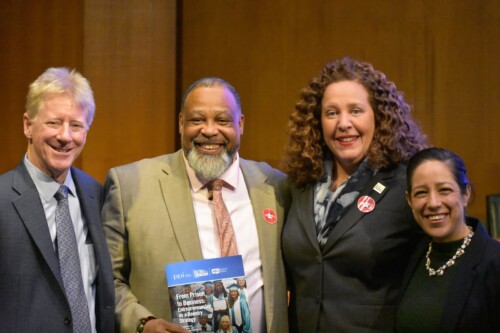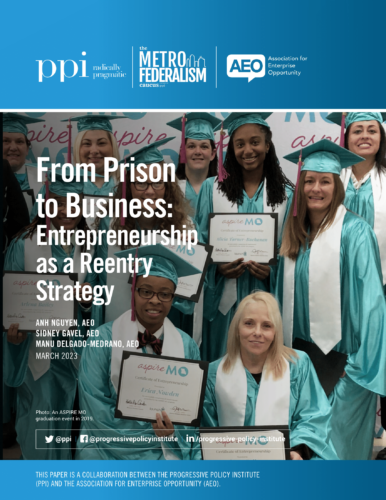
This week, Senator Ben Cardin (D-MD) joined the Progressive Policy Institute for a Capitol Hill briefing on the PPI Metro Federalism Caucus’s new report titled, “From Prison to Business: Entrepreneurship as a Reentry Strategy.” Senator Cardin, Chair of the Senate Small Business Committee, was joined by three panelists, Manu Delgado-Medrano, Research Director at Association for Enterprise Opportunity, Kristi C. Whitfield, Director of DC Department of Small & Local Business Development, and Maurice “Chef Reese” Dixon, Business owner who has participated in the DSLBD program. The discussion was moderated by New Democracy’s Matti Miranda.
In tandem with this week’s event, Senator Cardin introduced the Necessary Entrepreneurship Workshops via the SBA to Transform and Assist Re-Entry Training Act (NEW START) Act, which awards grants to provide entrepreneurial training and opportunities for returning citizens — previously incarcerated individuals — through a new reentry program within the U.S. Small Business Department (SBA).
“Entrepreneurship can be a critical lifeline for justice impacted individuals, and it can provide inherent benefits for their families and their communities. These entrepreneurs are less likely to recidivate and more likely to employ other justice impacted individuals, creating a positive multiplier effect,” said Chair Cardin. “I applaud the PPI report and appreciate their support for my NEW START legislation. The NEW START Act will help organizations that are on the ground administering entrepreneurial development programs and training to this community. The time has come to identify additional areas where we can come to a bipartisan consensus on how to produce meaningful change for the more than 70 million Americans with a criminal history,” said Senator Cardin, Chairman of the Small Business and Entrepreneurship Committee.
“Second chances are part of the American dream. Providing returning citizens the tools to turn their lives around through entrepreneurship is both a win for our national economy and our local economies. As our new report outlines, entrepreneurship is key in breaking the cycle of recidivism for returning citizens, and — with supports from federal and local policymakers — can be a method in overcoming major barriers to economic security. PPI applauds Chairman Cardin for his leadership in sponsoring the NEW START Act, and thanks the Senator for joining PPI for this timely Capitol Hill briefing on a critically important legislative priority,” said Will Marshall, President of the Progressive Policy Institute.
“Reform of our justice system must include reintegration support for those who were previously incarcerated as this report makes abundantly clear,” said Congresswoman Marilyn Strickland (WA-10), Co-Chair of PPI’s Metro Federalism Caucus.“We must do more to support critical training programs which allow returning citizens to build valuable skills and achieve economic security.”
“It’s important to understand there are two things that every human being has in common. One of them is that we all make mistakes. The other one is that mistake does not characterize who you are today. I say that because that’s the life of a returning citizen. Everyone that makes a mistake, is not who they are today. … What I’m thankful for is that I did not allow the stigma or the mistake to stop me from achieving,” said Maurice “Chef Reese” Dixon.
The U.S. has the highest incarceration rate in the world, and those who have a history of involvement with the justice system face barriers to economic security and reintegration into their communities. Entrepreneurship can be a way out of this cycle, but local and federal support is vital for success.
The briefing covered key themes and policy recommendations from the report, highlighting the need for significant reform to remove barriers that prevent those exiting the criminal justice system from achieving economic security and reintegration into their communities.
View the livestream from the event here and see photos here:

Read the Full Report Here:
The Progressive Policy Institute, in partnership with the Kauffman Foundation, has launched the Metro Federalism Caucus to advocate for a more direct and empowering relationship between national and local government leaders. The Caucus consists of former local officials who now serve in Congress, as well as accomplished mayors and former mayors from around the country, whose governing experience and insights can help U.S. policymakers reimagine the division of labor among national, state, and local governments. Its mission is to open a direct channel of communication that does not run through state governments, aimed at forging a stronger partnership between Washington and metro leaders. Organized and supported by PPI and Co-Chaired by Representative Marilyn Strickland (WA-10) and former Mayor of Kansas City Sly James, the Caucus will champion a new approach to federalism that channels resources and decision making directly to metro leaders. PPI calls this decentralizing dynamic “Metro Federalism.”
The Progressive Policy Institute (PPI) is a catalyst for policy innovation and political reform based in Washington, D.C. Its mission is to create radically pragmatic ideas for moving America beyond ideological and partisan deadlock. Learn more about PPI by visiting progressivepolicy.org.
For more than 30 years, Association for Enterprise Opportunity (AEO) and its over 2,700 member and partner organizations have helped millions of underserved entrepreneurs in starting, sustaining, and growing their businesses. Together, AEO is working to change the way that capital and services flow to underserved entrepreneurs so that they can create jobs and opportunities for all.
Follow the Progressive Policy Institute.
###
Media Contact: Tommy Kaelin; tkaelin@ppionline.org







 Left to right: Jordan Shapiro, Director of the Innovation Frontier Project, Progressive Policy Institute; Maryam Cope, Head of Government Affairs, ASML; Adrienne Elrod, Director of External Affairs for the CHIPS Program Office at the Department of Commerce.
Left to right: Jordan Shapiro, Director of the Innovation Frontier Project, Progressive Policy Institute; Maryam Cope, Head of Government Affairs, ASML; Adrienne Elrod, Director of External Affairs for the CHIPS Program Office at the Department of Commerce.